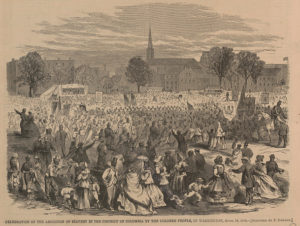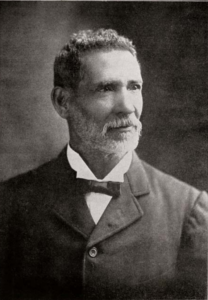Last updated on 28 décembre 2020
L’abolition de l’esclavage en 1865 avec la ratification du treizième amendement à la constitution des Etats-Unis ne règle pas la question du statut et des droits des afro-américains. Très vite, des Etats du Sud adoptent de nouvelles législations restreignant les droits des esclaves affranchis (parfois appelées « Black Codes« ).

L’objectif de ces législations, qui prennent souvent la forme de lois contre le vagabondage, est de maintenir une emprise très forte sur les anciens esclaves en encadrant leur travail et leurs déplacements [1]. Après la guerre civile, des centaines de milliers de noirs américains, pour la plupart anciens esclaves, se retrouvent sur les routes à la recherche d’un travail ou de membres de leur famille.
La loi sur le vagabondage promulguée en 1865 dans l’État du Mississippi prévoit ainsi que tout travailleur noir, qui n’a pas de logement ou contracté un emploi à compter du début du mois de janvier 1866, peut être arrêté pour vagabondage [2]. Celle de l’État de Virginie de 1866 contraint les personnes sans emploi ou sans domicile à un travail forcé pour une période pouvant aller jusqu’à trois mois [3]. D’autres lois interdisent les mariages mixtes, le droit de vote des noirs, le droit d’être juré ou de porter une arme, etc.
Le quatorzième amendement à la constitution des Etats-Unis est ratifié en 1868 pour répondre à ces législations en assurant aux anciens esclaves le statut de citoyen et en proclamant l’égale protection de tous en vertu de la loi. En 1870, le quinzième amendement leur garantit le droit de vote. Ces dispositions ne mettent pas un terme aux discriminations à l’encontre des anciens esclaves et de leurs descendants. A la fin des années 1870, des lois dites « Jim Crow » [4], inspirées des Black Codes de 1865-1866 et ceux d’avant guerre, instaurent dans de nombreux Etats une séparation entre les personnes « blanches » et celles dites « de couleur » dans les lieux publics (transports publics, écoles, etc.).

La loi adoptée en 1890 par l’Etat de Louisiane, connue sous le nom de « Separate Car Act« , en est un exemple [5]. Elle impose des compartiments différents dans les transports publics pour les blancs et les personnes de couleur et sanctionne l’infraction d’une amende de 25 dollars ou 20 jours de prison [6]. En 1891, Louis Martinet et Rodolphe Desdunes fondent le « Comité des Citoyens » à la Nouvelle-Orléans pour lutter pour l’abrogation de cette loi [7]. Ils font appel aux avocats Albion W. Tourgée et James C. Walker pour mener le combat juridique [8]. Les militants élaborent des stratégies pour créer des litiges susceptibles d’amener les juges à se prononcer sur la constitutionnalité de la loi. Ils demandent pour cela à plusieurs des leurs d’enfreindre le « Separate Car Act » et organisent leur arrestation [9].
Le 24 février 1892, le fils de Rodolphe Desdunes, Daniel Desdunes, musicien de profession, est arrêté après être monté à bord d’une voiture réservée aux blancs dans un train circulant de la Nouvelle-Orléans (Louisane) à Mobile (Alabama) [10]. Cette première affaire tourne vite court. Le juge John Howard Ferguson invalide l’inculpation de Desdunes au motif que le « Separate Car Act« , n’a vocation qu’à s’appliquer qu’à l’intérieur de l’Etat de Louisiane et non aux voyages entre deux Etats [11]. Le Comité célèbre cette demi-victoire [12].
Pour la deuxième tentative, les militants font appel à Homer Plessy, cordonnier [13]. Comme Daniel Desdunes, l’homme n’est pas choisi par hasard. Il est suffisamment blanc pour accéder au compartiment des blancs et assez noir au regard de la loi de Louisiane pour pouvoir être arrêté [14].
Le 7 juin 1897, Plessy achète un billet première classe pour un train reliant cette fois deux villes de Louisiane, Nouvelle-Orléans – Covington [15]. Il est arrêté comme prévu après s’être présenté comme un noir, avec la collaboration de la compagnie de chemin de fer (East Louisiana Railroad) et d’un détective privé engagé par le Comité [16]. Le juge John Howard Ferguson se prononce cette fois sur la constitutionnalité du « Separate Car Act » et déclare la loi en conformité avec les treizième et quatorzième amendements à la constitution [17]. La Cour suprême de Louisiane confirme sa décision en retenant que si le quatorzième amendement implique le même niveau de prestations pour les citoyens, il n’impose pas que celles-ci soient identiques ou partagées [18]. L’affaire est portée devant la Cour suprême des Etats-Unis.
à suivre…
1. [↑] Commence un esclavage d’un autre genre qui va durer jusqu’à la seconde guerre mondiale. selon l’écrivain et journaliste de New-York Times, Douglas A. Blackmon, prix Pulitzer en 2009 pour son ouvrage « Slavery by Another Name: The Re-Enslavement of Black Americans from the Civil War to World War II » (2008).
2. [↑] An Act to Confer Civil Rights on Freedmen, and for other Purposes, extrait : « All freedmen, free negroes and mulattoes in this State, over the age of eighteen years, found on the second Monday in January, 1866, or thereafter, with no lawful employment or business, or found unlawful assembling themselves together, either in the day or night time, and all white persons assembling themselves with freedmen, Free negroes or mulattoes, or usually associating with freedmen, free negroes or mulattoes, on terms of equality, or living in adultery or fornication with a freed woman, freed negro or mulatto, shall be deemed vagrants, and on conviction thereof shall be fined in a sum not exceeding, in the case of a freedman, free negro or mulatto, fifty dollars, and a white man two hundred dollars, and imprisonment at the discretion of the court, the free negro not exceeding ten days, and the white man not exceeding six months... ».
Extraits sur les sites : https://www.facinghistory.org/reconstruction-era/mississippi-black-codes-1865 ; http://web.mit.edu/21h.102/www/Primary%20source%20collections/Reconstruction/Black%20codes.htm.
3. [↑] Virginia Vagrancy Law, 15 janvier 1866, Chapitre 28.—An Act providing for the punishment of Vagrants.
Extrait : « 1. Be it enacted by the general assembly, That the overseers of the poor, or other officers having charge of the poor, or the special county police, or the police of any corporation, or any one or more of such persons, shall be and are hereby empowered and required, upon discovering any vagrant or vagrants within their respective counties or corporations, to make information thereof to any justice of the peace of their county or corporation, and to require a warrant for apprehending such vagrant or vagrants, to be brought before him or some other justice; and if, upon due examination, it shall appear that the person or persons are within the true description of a vagrant, as hereinafter mentioned, such justice shall, by warrant under his hand, order such vagrant or vagrants to be employed in labor for any term not exceeding three months, and, by any constable of such county or corporation, to be hired out for the best wages that can be procured; to be applied, except as hereafter provided, for the use of the vagrant or his family, as ordered by the justice. And if any without sufficient cause, run away from the person so employing him or them, he or they shall be apprehended, on the warrant of a justice, and returned to the custody of such hirer, who shall have, free of any further hire, the services of said vagrant for one month in addition to the original term of hiring; and said employer shall then have the power, if authorized by the justice, to work said vagrant, confined with ball and chain; or should said hirer decline to receive again said vagrant, then said vagrant shall be taken by the officer, upon the order of a justice, to the poor or work house, if there be any such in said county or corporation, and be delivered to the overseer or superintendent, who shall work said vagrant for the benefit of said county or corporation; or, if authorized by the justice, to work him, confined with ball and chain, for the period for which he would have had to serve his late employer, had he consented to receive him again; or should there be, when said runaway vagrant is apprehended, and public work going on in said county or corporation, then said vagrant, upon the order of a justice, shall be delivered over by said officer to the superintendent of such public work, who shall, for the like last mentioned period, work said vagrant on said public works, confined with ball and chain, if so authorized by the justice. But if there be no poor or work house in said county or corporation, and no public work then in progress therein, then, in that event, said justice may cause said vagrant to be delivered to any person who will take charge of him. Said person to have his services free of charge, except maintenance, for a like last mentioned period; and said person so receiving said vagrant is hereby empowered , if authorized by the justice, to work said vagrant confined with ball and chain; or should no such person be found, then said vagrant is to be committed to the county jail, there to be confined for the like period, and fed on bread and water. But the persons described as the fifth class of vagrants, in the second section of this act, may be arrested without warrant by the special county or corporation police, and when so arrested shall be taken before a justice, who shall proceed to dispose of them in the mode prescribed in this section, or may at once direct them to be committed to prison for a period not exceeding three months, to be kept in close confinement and fed on bread and water. »
Voir l’article Vagrancy Act of 1866 de Brent Tarter sur le site www.encyclopediavirginia.org.
4. [↑] Voir à ce sujet l’article précédent : L’arrêt Plessy v. Ferguson du 18 mai 1896 (I) : la validation de la ségrégation par la Cour Suprême des Etats-Unis.
5. [↑] Voir l’ouvrage « Separate: The Story of Plessy v. Ferguson, and America’s Journey from Slavery to Segregation« , de Steve Luxenberg, 2019, chapitres 18 et 19 ; l’ouvrage « Race and Schooling in the South, 1880-1950: An Economic History« , de Robert A. Margo, 1990, page 68.
6. [↑] Idem, Robert A. Margo, 1990, page 68.
7. [↑] Idem, Steve Luxenberg, 2019, chapitre 19 ; voir l’article « Overlooked No More: Homer Plessy, Who Sat on a Train and Stood Up for Civil Rights« , de Glenn Rifkin, The New-York Times, 31 janvier 2020.
8. [↑] Idem, Steve Luxenberg, 2019, chapitre 19.
9. [↑] Idem, Steve Luxenberg, 2019, chapitre 19.
10. [↑] Idem, Steve Luxenberg, 2019, chapitre 20.
11. [↑] Idem, Steve Luxenberg, 2019, chapitre 20.
12. [↑] Idem, Steve Luxenberg, 2019, chapitre 20.
13. [↑] Voir l’ouvrage « We As Freemen: Plessy V. Ferguson« , de Keith Weldon Medley, 2003, chapitre 1 ; idem, Glenn Rifkin, The New-York Times, 31 janvier 2020.
14. [↑] Idem, Keith Weldon Medley, 2003, chapitre 1, idem, Steve Luxenberg, 2019, chapitre 20.
15. [↑] Idem, Steve Luxenberg, 2019, chapitre 20.
16. [↑] Le contrôle est planifié avec le conducteur de train et l’arrestation est faite par le détective privé Chris C. Cain engagé par le Comité des Cotoyens. Voir l’ouvrage « Separate: The Story of Plessy v. Ferguson, and America’s Journey from Slavery to Segregation« , de Steve Luxenberg, 2019, chapitre 20.
17. [↑] Idem, Glenn Rifkin, The New-York Times, 31 janvier 2020 ; idem, Steve Luxenberg, 2019, chapitre 20.
18. [↑] Voir l’article « In the Shadow of Plessy« , de Cheryl L Harris, Journal of Constitutional Law, volume 7.3, février 2005, page 891: « principle that, in such matters, equality, and not identity or community, of accommodations is the extreme test of conformity to the requirements of the [F]ourteenth [A] mendment« .


